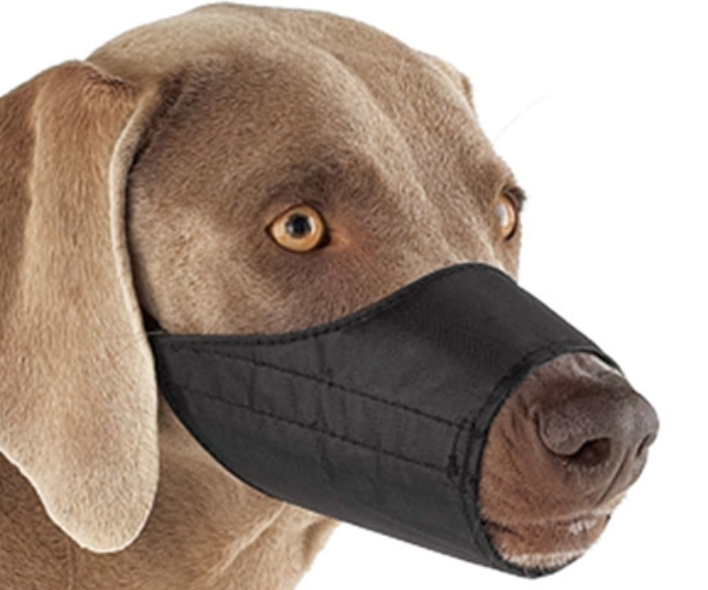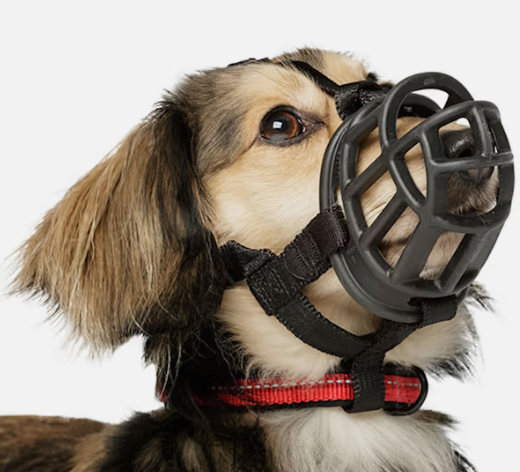Dog muzzles are a type of gear that can be used to keep a dog's mouth closed in various situations. They are designed to fit securely over a dog's snout and can be made from different materials such as leather, nylon, or mesh. Muzzles can be an important tool for dog owners to help prevent their pets from biting, chewing, or barking excessively. In addition, they can also be used for medical reasons, such as preventing a dog from licking or scratching a wound, or during grooming or veterinary procedures.
Using a muzzle on a dog is not an indication of aggression or bad behavior. In fact, it can be a responsible choice for dog owners to keep both their pets and other people or animals safe in certain situations.
For example, a muzzle may be necessary if a dog is undergoing a medical treatment or examination that may be painful or stressful. Additionally, in some areas, dog owners may be required by law to use a muzzle in public spaces if their dog has a history of aggression or biting. Overall, dog muzzles can be an effective and humane way to manage a dog's behavior and ensure the safety of everyone involved.
Types of Dog Muzzles
Understanding the different designs and materials:
There are several types of dog muzzles available on the market today, each with their own unique design and materials. One of the most common types is the basket muzzle, which is made from wire, plastic, or rubber and allows a dog to open its mouth and pant, drink water, and take treats. This type of muzzle is often used during veterinary examinations, grooming, or training sessions.
Another type of muzzle is the soft muzzle, which is made from materials such as nylon or mesh and fits over a dog's snout, restricting its ability to open its mouth. While this type of muzzle is not as effective in preventing biting, it can still be used to prevent a dog from chewing or licking a wound or during grooming sessions.
Leather muzzles are another popular choice, as they are durable and can be more comfortable for dogs to wear for longer periods of time. They are also less likely to break or crack in extreme temperatures compared to other materials. However, leather muzzles can be difficult to clean and may not be suitable for dogs with sensitive skin.
It is important to choose the right type of muzzle for your dog's specific needs and to ensure that it fits properly to prevent discomfort or injury. Consult with a veterinarian or professional trainer if you are unsure which type of muzzle to choose or how to properly fit it on your dog.
How to choose the right muzzle for your dog: Factors to consider
When choosing a muzzle for your dog, it's important to consider several factors to ensure that you select the right type for your pet's specific needs. Here are some things to keep in mind:
- Size: Make sure to measure your dog's snout and choose a muzzle that fits properly. A muzzle that is too small can cause discomfort or injury, while a muzzle that is too large may not be effective in preventing biting.
- Purpose: Consider why you need a muzzle for your dog. Is it to prevent biting, chewing, or barking? Is it for medical reasons, such as preventing your dog from licking a wound or taking off a bandage? Different types of muzzles are designed for different purposes, so choose the one that best suits your needs.
- Material: Think about the material that the muzzle is made from. Some dogs may be more comfortable with a certain type of material, while others may need a sturdier or more durable muzzle.
- Breathability: Ensure that the muzzle allows your dog to breathe comfortably and pant, drink water, or take treats if necessary. A muzzle that restricts breathing can be dangerous for your dog, especially during hot weather or physical activity.
- Comfort: Choose a muzzle that is comfortable for your dog to wear for extended periods of time. A muzzle that is too tight or rubs against the skin can cause discomfort or injury.
By considering these factors, you can choose a muzzle that is safe, effective, and comfortable for your dog to wear. Remember to always supervise your dog when using a muzzle and never leave them unsupervised while wearing one.
Training your dog to wear a muzzle
Below are some simple steps to follow to help introduce the muzzle to your dog.
Step-by-step guide:
- Introduce the muzzle: Show your dog the muzzle and let them sniff it. Encourage them to approach it and interact with it without forcing them to wear it.
- Reward positive behavior: When your dog shows interest in the muzzle or approaches it willingly, reward them with a treat or praise.
- Touch the muzzle to your dog's face: Once your dog is comfortable with the muzzle, touch it to their face and reward them with a treat or praise. Repeat this step several times until your dog is comfortable with the muzzle touching their face.
- Place a treat inside the muzzle: Put a treat inside the muzzle and allow your dog to eat it. Repeat this step several times, gradually increasing the amount of time your dog spends with the muzzle on.
- Secure the muzzle: Once your dog is comfortable with the muzzle on their face, secure it in place and reward them with a treat or praise. Start with short periods of time and gradually increase the amount of time your dog wears the muzzle.
- Practice with distractions: Practice having your dog wear the muzzle while doing things they enjoy, such as going for a walk or playing with a toy. This will help them associate the muzzle with positive experiences.
- Increase the difficulty: Once your dog is comfortable wearing the muzzle in a familiar environment, gradually increase the difficulty by adding distractions or going to new places.
Remember to be patient and positive throughout the training process. Never force your dog to wear a muzzle or punish them for resisting. With patience and consistency, your dog can learn to wear a muzzle comfortably and safely.

Using a muzzle in different situations
Dog muzzles can be used in a variety of situations to help keep both your pet and others safe. Here are some common situations where a muzzle may be necessary:
- Vet visits: A muzzle can be used during veterinary examinations or treatments to prevent your dog from biting or injuring the veterinarian or veterinary staff. It can also help your dog feel more secure and calm during these procedures.
- Grooming: Some dogs may become anxious or aggressive during grooming sessions, which can make it difficult for the groomer to safely trim their fur or nails. A muzzle can help prevent biting or aggression during these sessions.
- Socialization: If your dog is not well-socialized or has a history of aggression towards other dogs or people, a muzzle can be used to prevent biting or injury during interactions.
- Travel: Some dogs may become anxious or aggressive during travel, which can be dangerous for both your pet and others around them. A muzzle can help prevent biting or aggression during these situations.
- Emergency situations: In case of an emergency, such as a natural disaster or injury, a muzzle can help prevent your dog from biting or injuring others during transport or treatment.
Remember to always supervise your dog when using a muzzle and never leave them unsupervised while wearing one. Additionally, it is important to use positive reinforcement and reward your dog for wearing the muzzle and displaying calm behavior. With proper use and training, a muzzle can be a safe and effective tool for managing your dog's behavior in different situations.
The Do's and Don'ts of Muzzles
When using a dog muzzle, it's important to follow some safety tips to ensure your dog's well-being and the well-being of others. Here are some dos and don'ts to keep in mind:
DOs:
- Choose the right size and type of muzzle for your dog's specific needs and ensure that it fits properly.
- Introduce the muzzle gradually and use positive reinforcement to help your dog feel comfortable wearing it.
- Monitor your dog's behavior while wearing the muzzle to ensure that they are not experiencing discomfort or injury.
- Use the muzzle only when necessary and never as a punishment or as a substitute for proper training and socialization.
- Consult with a veterinarian or professional trainer if you have any concerns or questions about using a muzzle on your dog.
DON'Ts:
- Never leave your dog unsupervised while wearing a muzzle.
- Never use a muzzle as a means of punishing your dog for bad behavior.
- Never force your dog to wear a muzzle if they are uncomfortable or distressed.
- Never leave a muzzle on for extended periods of time or in extreme temperatures.
- Never use a muzzle as a substitute for proper training and socialization.
Remember to always prioritize your dog's well-being and use a muzzle responsibly and ethically. By following these safety tips, you can ensure that your dog and others around them remain safe and secure while wearing a muzzle.

Final Thoughts
Dog muzzles can be a valuable tool for pet owners to manage their dog's behavior and ensure the safety of everyone involved. By choosing the right type of muzzle, properly fitting it, and introducing it gradually, you can help your dog feel comfortable and secure while wearing it.
Additionally, it's important to use a muzzle responsibly and ethically, and to prioritize your dog's well-being at all times. Whether you're using a muzzle during vet visits, grooming, or other situations, remember to always supervise your dog and provide positive reinforcement to help them associate the muzzle with positive experiences. By using a muzzle in a safe and responsible manner, you can help ensure a happy and healthy life for your furry friend.
Get more expert advice on pet-parenting by visiting the Off Leash blog at TryFi.com.
TryFi's The Fi Dog Collar is a must-have for any pet parent, it's a GPS tracking collar that helps you keep tabs on your dog's location, activity, and sleep patterns, and alerts you if they escape your backyard. Try the Fi Dog Collar today!





